formerly eScholarship Editions


|
|
|
|
Your request for similar items found 20 book(s). | Modify Search | Displaying 1 - 20 of 20 book(s) | |
| 1. | 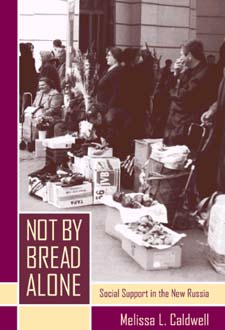 | Title: Not by bread alone: social support in the new Russia Author: Caldwell, Melissa L 1969- Published: University of California Press, 2004 Subjects: Anthropology | Russian and Eastern European Studies | European Studies Publisher's Description: What Muscovites get in a soup kitchen run by the Christian Church of Moscow is something far more subtle and complex - if no less necessary and nourishing - than the food that feeds their hunger. In Not by Bread Alone, the first full-length ethnographic study of poverty and social welfare in the postsocialist world, Melissa L. Caldwell focuses on the everyday operations and civil transactions at CCM soup kitchens to reveal the new realities, the enduring features, and the intriguing subtext of social support in Russia today. In an international food aid community, Caldwell explores how Muscovites employ a number of improvisational tactics to satisfy their material needs. She shows how the relationships that develop among members of this community - elderly Muscovite recipients, Russian aid workers, African student volunteers, and North American and European donors and volunteers - provide forms of social support that are highly valued and ultimately far more important than material resources. In Not by Bread Alone we see how the soup kitchens become sites of social stability and refuge for all who interact there - not just those with limited financial means - and how Muscovites articulate definitions of hunger and poverty that depend far more on the extent of one's social contacts than on material factors. By rethinking the ways in which relationships between social and economic practices are theorized - by identifying social relations and social status as Russia's true economic currency - this book challenges prevailing ideas about the role of the state, the nature of poverty and welfare, the feasibility of Western-style reforms, and the primacy of social connections in the daily lives of ordinary people in post-Soviet Russia. [brief] Similar Items |
| 2. | 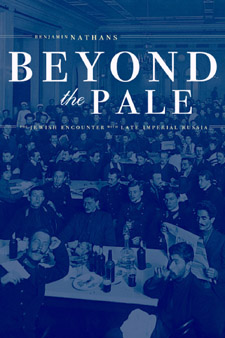 | Title: Beyond the pale: the Jewish encounter with late imperial Russia Author: Nathans, Benjamin Published: University of California Press, 2002 Subjects: History | Jewish Studies | Russian and Eastern European Studies Publisher's Description: A surprising number of Jews lived, literally and figuratively, "beyond the Pale" of Jewish Settlement in tsarist Russia during the half-century before the Revolution of 1917. Thanks to the availability of long-closed Russian archives, along with a wide range of other sources, Benjamin Nathans reinterprets the history of the Russian-Jewish encounter. In the wake of Russia's "Great Reforms," Nathans writes, a policy of selective integration stimulated social and geographic mobility among the empire's Jews. The reaction that culminated, toward the turn of the century, in ethnic restrictions on admission to universities, the professions, and other institutions of civil society reflected broad anxieties that Russians were being placed at a disadvantage in their own empire. Nathans's conclusions about the effects of selective integration and the Russian-Jewish encounter during this formative period will be of great interest to all students of modern Jewish and modern Russian history. [brief] Similar Items |
| 3. | 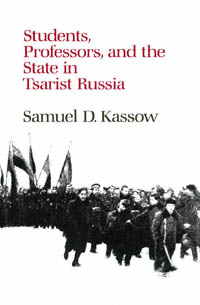 | Title: Students, professors, and the state in tsarist Russia Author: Kassow, Samuel D Published: University of California Press, 1989 Subjects: History | European History Publisher's Description: Between 1899 and 1911, student strikes and demonstrations disrupted Russia's higher educational institutions. The universities marched to their own peculiar tempo, however, and it was not until the strike of 1905 that student unrest coincided with mass movements outside the academic world. Students, Professors, and the State in Tsarist Russia , the first comprehensive study of the student movement during the waning decades of tsarist rule, centers on the interplay among student protest, faculty politics, and government policy toward the universities. The author examines the changing responses of students, faculty, and government officials to the crisis of the university and the old regime, throwing new light on the chronic political and social instability of the tsarist system. Kassow's familiarity with source material and his use of narratives from participants and observers alike provide both a trenchant analysis and a lively portrait of the times. Original and incisive, this book will be welcomed not only by specialists in the Russian field, but also by anyone interested in the dynamics of student protest and the role of the intellectual in popular movements. [brief] Similar Items |
| 4. | 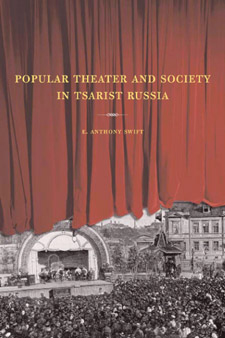 | Title: Popular theater and society in Tsarist Russia Author: Swift, Eugene Anthony Published: University of California Press, 2002 Subjects: History | European History | Russian and Eastern European Studies | Popular Culture | European Literature | European Studies Publisher's Description: This is the most comprehensive study available of the popular theater that developed during the last decades of tsarist Russia. Swift examines the origins and significance of the new "people's theaters" that were created for the lower classes in St. Petersburg and Moscow between 1861 and 1917. His extensively researched study, full of anecdotes from the theater world of the day, shows how these people's theaters became a major arena in which the cultural contests of late imperial Russia were played out and how they contributed to the emergence of an urban consumer culture during this period of rapid social and political change. Swift illuminates many aspects of the story of these popular theaters - the cultural politics and aesthetic ambitions of theater directors and actors, state censorship politics and their role in shaping the theatrical repertoire, and the theater as a vehicle for social and political reform. He looks at roots of the theaters, discusses specific theaters and performances, and explores in particular how popular audiences responded to the plays. [brief] Similar Items |
| 5. | 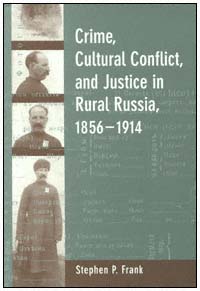 | Title: Crime, cultural conflict, and justice in rural Russia, 1856-1914 Author: Frank, Stephen 1955- Published: University of California Press, 1999 Subjects: History | Russian and Eastern European Studies | Cultural Anthropology | Social Problems | European History | Law | Criminology Publisher's Description: This book is the first to explore the largely unknown world of rural crime and justice in post-emancipation Imperial Russia. Drawing upon previously untapped provincial archives and a wealth of other neglected primary material, Stephen P. Frank offers a major reassessment of the interactions between peasantry and the state in the decades leading up to World War I. Viewing crime and punishment as contested metaphors about social order, his revisionist study documents the varied understandings of criminality and justice that underlay deep conflicts in Russian society, and it contrasts official and elite representations of rural criminality - and of peasants - with the realities of everyday crime at the village level. [brief] Similar Items |
| 6. | 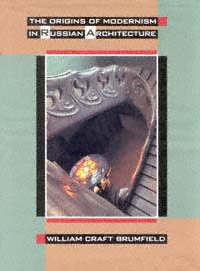 | Title: The origins of modernism in Russian architecture Author: Brumfield, William Craft 1944- Published: University of California Press, 1991 Subjects: Architecture | Architectural History | Russian and Eastern European Studies Publisher's Description: The dramatic transformation of Russian architecture from the 1880s to the 1917 revolution reflected the profound changes in Russian society as it entered the modern industrial age. William Craft Brumfield examines the extraordinary diversity of architectural styles in this period and traces the search by architects and critics for a "unifying idea" that would define a new architecture. Generously illustrated with archival materials and with the author's own superb photographs, this is the first comprehensive study by a Western scholar of a neglected period in European architectural and cultural history.Brumfield explores the diverse styles of Russian modernism in part by analyzing the contemporary theoretical debate about them: the relation between technology and style, the obligation of architecture to society, and the role of architecture as an expression of national identity. Steeped in controversy, Russian modernism at the beginning of the century foreshadowed the radical restructuring of architectural form in the Soviet Union during the two decades after the revolution. This authoritative work provides a new understanding of Russian architecture's last brief entrepreneurial episode and offers insight on our own era, when individual freedom and initiative may once again find expression in Russian architecture. [brief] Similar Items |
| 7. | 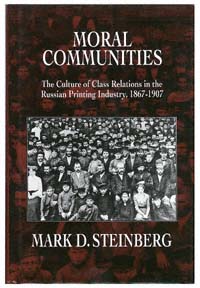 | Title: Moral communities: the culture of class relations in the Russian printing industry, 1867-1907 Author: Steinberg, Mark Published: University of California Press, 1992 Subjects: History | European History | Russian and Eastern European Studies Publisher's Description: This valuable study offers a rare perspective on the social and political crisis in late Imperial Russia. Mark D. Steinberg focuses on employers, supervisors, and workers in the printing industry as it evolved from a state-dependent handicraft to a capitalist industry. He explores class relations and the values, norms, and perceptions with which they were made meaningful. Using archival and printed sources, Steinberg examines economic changes, workplace relations, professional organizations, unions, strikes, and political activism, as well as shop customs, trade festivals, and everyday life. In rich detail he describes efforts to build a community of masters and men united by shared interests and moral norms. The collapse of this ideal in the face of growing class conflict is also explored, giving a full view of an important moment in Russian history. [brief] Similar Items |
| 8. | 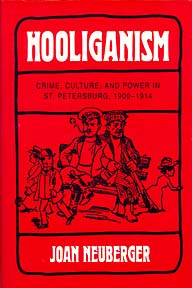 | Title: Hooliganism: crime, culture, and power in St. Petersburg, 1900-1914 Author: Neuberger, Joan Published: University of California Press, 1993 Subjects: History | Politics | Russian and Eastern European Studies | Criminology Publisher's Description: n this pioneering analysis of diffuse underclass anger that simmers in many societies, Joan Neuberger takes us to the streets of St. Petersburg in 1900-1914 to show us how the phenomenon labeled hooliganism came to symbolize all that was wrong with the modern city: increasing hostility between class . . . [more] Similar Items |
| 9. | 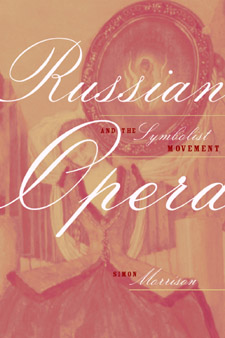 | Title: Russian opera and the symbolist movement Author: Morrison, Simon Alexander 1964- Published: University of California Press, 2002 Subjects: Music | Opera | Musicology | Composers | Russian and Eastern European Studies | Literature Publisher's Description: An aesthetic, historical, and theoretical study of four scores, Russian Opera and the Symbolist Movement is a groundbreaking and imaginative treatment of the important yet neglected topic of Russian opera in the Silver Age. Spanning the gap between the supernatural Russian music of the nineteenth century and the compositions of Prokofiev and Stravinsky, this exceptionally insightful and well-researched book explores how Russian symbolist poets interpreted opera and prompted operatic innovation. Simon Morrison shows how these works, though stylistically and technically different, reveal the extent to which the operatic representation of the miraculous can be translated into its enactment. Morrison treats these largely unstudied pieces by canonical composers: Tchaikovsky's Queen of Spades, Rimsky-Korsakov's Legend of the Invisible City of Kitezh and the Maiden Fevroniya, Scriabin's unfinished Mysterium, and Prokofiev's Fiery Angel. The chapters, revisionist studies of these composers and scores, address separate aspects of Symbolist poetics, discussing such topics as literary and musical decadence, pagan-Christian syncretism, theurgy, and life creation, or the portrayal of art in life. The appendix offers the first complete English-language translation of Scriabin's libretto for the Preparatory Act. Providing valuable insight into both the Symbolist enterprise and Russian musicology, this book casts new light on opera's evolving, ambiguous place in fin de siècle culture. [brief] Similar Items |
| 10. | 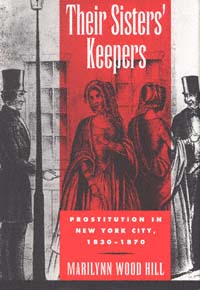 | Title: Their sisters' keepers: prostitution in New York City, 1830-1870 Author: Hill, Marilynn Wood Published: University of California Press, 1993 Subjects: History | United States History | Women's Studies | American Studies Publisher's Description: This intimate study of prostitutes in New York City during the mid-nineteenth century reveals these women in an entirely new light. Unlike traditional studies, Marilynn Wood Hill's account of prostitution's positive attractions, as well as its negative aspects, gives a fresh perspective to this much-discussed occupation.Using a wealth of primary source material, from tax and court records to brothel guidebooks and personal correspondence, Hill shows the common concerns prostitutes shared with women outside the "profession." As mothers, sisters, daughters, and wives, trapped by circumstances, they sought a way to create a life and work culture for themselves and those they cared about.By the 1830s prostitution in New York was no longer hidden. Though officially outside the law, it was well integrated into the city's urban life. Hill documents the discrimination and legal harassment prostitutes suffered, and shows how they asserted their rights to protect themselves and their property. Although their occupation was frequently degrading and dangerous, it offered economic and social opportunities for many of its practitioners. Women controlled the prostitution business until about 1870, and during this period female employers and their employees often achieved economic goals not generally available to other working women.While examining aspects of prostitution that benefited women, Hill's vivid portrayal also makes evident the hardships that prostitutes endured. What emerges is a fully rounded study that will be welcomed by many readers. [brief] Similar Items |
| 11. | 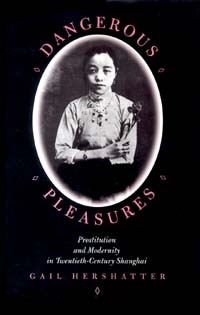 | Title: Dangerous pleasures: prostitution and modernity in twentieth-century Shanghai Author: Hershatter, Gail Published: University of California Press, 1997 Subjects: History | Women's Studies | China Publisher's Description: This pioneering work examines prostitution in Shanghai from the late nineteenth century to the present. Drawn mostly from the daughters and wives of the working poor and declassè elites, prostitutes in Shanghai were near the bottom of class and gender hierarchies. Yet they were central figures in Shanghai urban life, entering the historical record whenever others wanted to appreciate, castigate, count, regulate, cure, pathologize, warn about, rescue, eliminate, or deploy them as a symbol in a larger social panorama.Over the past century, prostitution has been understood in many ways: as a source of urbanized pleasures, a profession full of unscrupulous and greedy schemers, a changing site of work for women, a source of moral danger and physical disease, a marker of national decay, and a sign of modernity. For the Communist leadership of the 1950s, the elimination of prostitution symbolized China's emergence as a strong, healthy, and modern nation. In the past decade, as prostitution once again has become a recognized feature of Chinese society, it has been incorporated into a larger public discussion about what kind of modernity China should seek and what kind of sex and gender arrangements should characterize that modernity.Prostitutes, like every other non-elite group, did not record their own lives. How can sources generated by intense public argument about the "larger" meanings of prostitution be read for clues to those lives? Hershatter makes use of a broad range of materials: guidebooks to the pleasure quarters, collections of anecdotes about high-class courtesans, tabloid gossip columns, municipal regulations prohibiting street soliciting, police interrogations of streetwalkers and those accused of trafficking in women, newspaper reports on court cases involving both courtesans and streetwalkers, polemics by Chinese and foreign reformers, learned articles by Chinese scholars commenting on the world history of prostitution and analyzing its local causes, surveys by doctors and social workers on sexually transmitted disease in various Shanghai populations, relief agency records, fictionalized accounts of the scams and sufferings of prostitutes, memoirs by former courtesan house patrons, and interviews with former officials and reformers.Although a courtesan may never set pen to paper, we can infer a great deal about her strategizing and working of the system through the vast cautionary literature that tells her customers how not to be defrauded by her. Newspaper accounts of the arrests and brief court testimonies of Shanghai streetwalkers let us glimpse the way that prostitutes positioned themselves to get the most they could from the legal system. Without recourse to direct speech, Hershatter argues, these women have nevertheless left an audible trace. Central to this study is the investigation of how things are known and later remembered, and how, later still, they are simultaneously apprehended and reinvented by the historian. [brief] Similar Items |
| 12. | 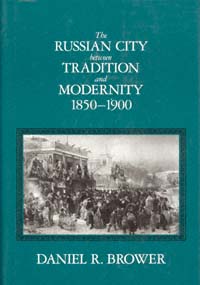 | Title: The Russian city between tradition and modernity, 1850-1900 Author: Brower, Daniel R Published: University of California Press, 1990 Subjects: History | European History | Russian and Eastern European Studies | Urban Studies Publisher's Description: The Russian City Between Tradition and Modernity provides a comprehensive history of urban development in European Russia during the last half of the nineteenth century. Using both statistical perspectives on urbanization and cultural representations of the city, Brower constructs a synthetic view of the remaking of urban Russia. He argues that the reformed municipalities succeeded in creating an embryonic civil society among the urban elite but failed to fashion a unified, orderly city. By the end of the century, the cities confronted social disorder of a magnitude that resembled latent civil war.Drawing on a wide range of archival and published sources, including census materials and reports from municipal leaders and tsarist officials, Brower offers a new approach to the social history of Russia. The author emphasizes the impact of the massive influx of migrants on the country's urban centers, whose presence dominated the social landscape of the city. He outlines the array of practices by which the migrant laborers adapted to urban living and stresses the cultural barriers that isolated them from the well-to-do urban population. Brower suggests that future scholarship should pay particular attention to the duality between the sweeping visions of social progress of the elite and the unique practices of the urban workforce. This contradiction, he argues, offers a key explanation for the social instability of imperial Russia in the closing decades of the nineteenth century. [brief] Similar Items |
| 13. | 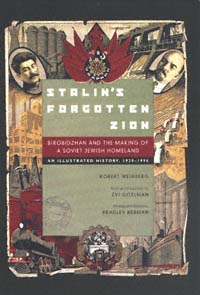 | Title: Stalin's forgotten Zion: Birobidzhan and the making of a Soviet Jewish homeland: an illustrated history, 1928-1996 Author: Weinberg, Robert E Published: University of California Press, 1998 Subjects: Jewish Studies | Russian and Eastern European Studies | History | Politics | Judaism Publisher's Description: Robert Weinberg and Bradley Berman's carefully documented and extensively illustrated book explores the Soviet government's failed experiment to create a socialist Jewish homeland. In 1934 an area popularly known as Birobidzhan, a sparsely populated region along the Sino-Soviet border some five thousand miles east of Moscow, was designated the national homeland of Soviet Jewry. Establishing the Jewish Autonomous Region was part of the Kremlin's plan to create an enclave where secular Jewish culture rooted in Yiddish and socialism could serve as an alternative to Palestine. The Kremlin also considered the region a solution to various perceived problems besetting Soviet Jews. Birobidzhan still exists today, but despite its continued official status Jews are a small minority of the inhabitants of the region. Drawing upon documents from archives in Moscow and Birobidzhan, as well as photograph collections never seen outside Birobidzhan, Weinberg's story of the Soviet Zion sheds new light on a host of important historical and contemporary issues regarding Jewish identity, community, and culture. Given the persistence of the "Jewish question" in Russia, the history of Birobidzhan provides an unusual point of entry into examining the fate of Soviet Jewry under communist rule. [brief] Similar Items |
| 14. | 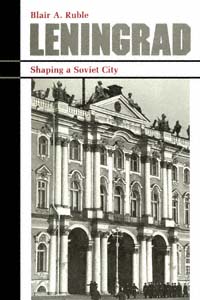 | Title: Leningrad: shaping a Soviet city Author: Ruble, Blair A 1949- Published: University of California Press, 1990 Subjects: Russian and Eastern European Studies | European History Publisher's Description: Throughout much of this century, cities around the world have sought to gain control over their urban destinies through concerted government action. Nowhere has this process of state intervention gone further than in the Soviet Union. This volume explores the ways in which local and regional political, economic, and cultural leaders in Leningrad determine the physical and socioeconomic contours of their city and region within such a centralized economic and political environment.The author examines four major policy initiatives that have emerged in Leningrad since the 1950s - physical planning innovations, integrated scientific-production associations, vocational education reform, and socioeconomic planning - and that have been anchored in attempts to plan and manage metropolitan Leningrad. Each initiative illuminates the bureaucratic and political strategies employed to obtain economic objectives, as well as the bureaucratic patterns which distinguish market and non-market experiences. The boundaries for autonomous action by local Soviet politicians, planners, and managers emerge through this inquiry. [brief] Similar Items |
| 15. |  | Title: Smallpox: the fight to eradicate a global scourge Author: Koplow, David A 1951- Published: University of California Press, 2003 Subjects: Politics | American Studies | Public Policy | Disease Publisher's Description: Though smallpox was eradicated from the planet two decades ago, recent terrorist acts have raised the horrific possibility that rogue states, laboratories, or terrorist groups are in possession of secret stockpiles of the virus that causes the disease, and may be preparing to unleash it on target populations. Because it is a far deadlier killer than other biological warfare agents such as anthrax, and because the universal vaccination against smallpox was halted decades ago, a smallpox attack today would be nothing short of catastrophic. This clear, authoritative study looks at the long and fascinating history of the virus, with an informative overview of the political, biological, environmental, medical, and legal issues surrounding the question of whether or not the virus should be exterminated. The only two known samples of the virus are currently stored in Atlanta and Russia. The World Health Organization has repeatedly scheduled their destruction - an action that would rid the planet of all publicly acknowledged smallpox strains forever. Opponents of this plan argue that by destroying these last samples we are denying the possibility that this unique virus could be turned to beneficial purposes in basic scientific research. Others see the stockpile as part of a deterrent against future germ attacks. Proponents of prompt eradication argue that scientists have already learned all they can from this particular virus, and that by destroying the stockpile we are preventing it from ever falling into the wrong hands. As a thirty-year veteran of arms control issues, David Koplow is uniquely suited to provide readers with an informed and well-considered understanding of the complexities involved in the handling of this deadly virus. [brief] Similar Items |
| 16. | 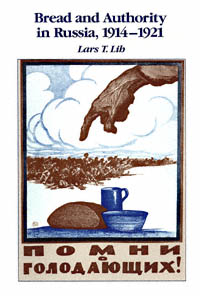 | Title: Bread and authority in Russia, 1914-1921 Author: Lih, Lars T Published: University of California Press, 1990 Subjects: History | European History | Politics | Russian and Eastern European Studies Publisher's Description: Between 1914 and 1921, Russia experienced a national crisis that destroyed the tsarist state and led to the establishment of the new Bolshevik order. During this period of war, revolution, and civil war, there was a food-supply crisis. Although Russia was one of the world's major grain exporters, the country was no longer capable of feeding its own people. The hunger of the urban workers increased the pace of revolutionary events in 1917 and 1918, and the food-supply policy during the civil war became the most detested symbol of the hardships imposed by the Bolsheviks.Focusing on this crisis, Lars Lih examines the fundamental process of political and social breakdown and reconstitution. He argues that this seven-year period is the key to understanding the Russian revolution and its aftermath. In 1921 the Bolsheviks rejected the food-supply policy established during the civil war; sixty-five years later, Mikhail Gorbachev made this change of policy a symbol of perestroika. Since then, more attention has been given both in the West and in the Soviet Union to the early years of the revolution as one source of the tragedies of Stalinist oppression.Lih's argument is based on a great variety of source material - archives, memoirs, novels, political rhetoric, pamphlets, and propoganda posters. His new study will be read with profit by all who are interested in the drama of the Russian revolution, the roots of both Stalinism and anti-Stalin reform, and more generally in a new way of understanding the effects of social and political breakdown. [brief] Similar Items |
| 17. | 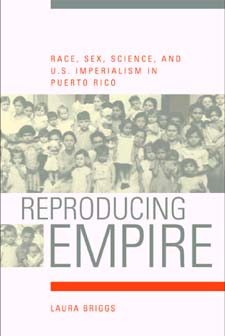 | Title: Reproducing empire: race, sex, science, and U.S. imperialism in Puerto Rico Author: Briggs, Laura 1964- Published: University of California Press, 2003 Subjects: History | Ethnic Studies | Medicine | United States History | Women's Studies | Gender Studies Publisher's Description: Original and compelling, Laura Briggs's Reproducing Empire shows how, for both Puerto Ricans and North Americans, ideologies of sexuality, reproduction, and gender have shaped relations between the island and the mainland. From science to public policy, the "culture of poverty" to overpopulation, feminism to Puerto Rican nationalism, this book uncovers the persistence of concerns about motherhood, prostitution, and family in shaping the beliefs and practices of virtually every player in the twentieth-century drama of Puerto Rican colonialism. In this way, it sheds light on the legacies haunting contemporary debates over globalization. Puerto Rico is a perfect lens through which to examine colonialism and globalization because for the past century it has been where the United States has expressed and fine-tuned its attitudes toward its own expansionism. Puerto Rico's history holds no simple lessons for present-day debate over globalization but does unearth some of its history. Reproducing Empire suggests that interventionist discourses of rescue, family, and sexuality fueled U.S. imperial projects and organized American colonialism. Through the politics, biology, and medicine of eugenics, prostitution, and birth control, the United States has justified its presence in the territory's politics and society. Briggs makes an innovative contribution to Puerto Rican and U.S. history, effectively arguing that gender has been crucial to the relationship between the United States and Puerto Rico, and more broadly, to U.S. expansion elsewhere. [brief] Similar Items |
| 18. | 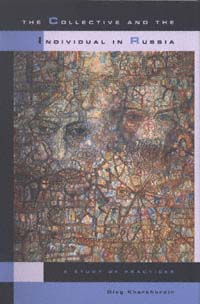 | Title: The collective and the individual in Russia: a study of practices Author: Kharkhordin, Oleg 1964- Published: University of California Press, 1999 Subjects: History | Social Theory | European History | Russian and Eastern European Studies | Intellectual History Publisher's Description: Oleg Kharkhordin has constructed a compelling, subtle, and complex genealogy of the Soviet individual that is as much about Michel Foucault as it is about Russia. Examining the period from the Russian Revolution to the fall of Gorbachev, Kharkhordin demonstrates that Party rituals - which forced each Communist to reflect intensely and repeatedly on his or her "self," an entirely novel experience for many of them - had their antecedents in the Orthodox Christian practices of doing penance in the public gaze. Individualization in Soviet Russia occurred through the intensification of these public penitential practices rather than the private confessional practices that are characteristic of Western Christianity. He also finds that objectification of the individual in Russia relied on practices of mutual surveillance among peers, rather than on the hierarchical surveillance of subordinates by superiors that characterized the West. The implications of this book expand well beyond its brilliant analysis of the connection between Bolshevism and Eastern Orthodoxy to shed light on many questions about the nature of Russian society and culture. [brief] Similar Items |
| 19. | 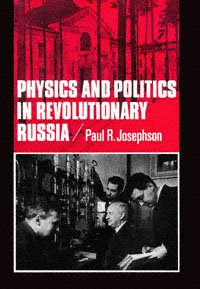 | Title: Physics and politics in revolutionary Russia Author: Josephson, Paul R Published: University of California Press, 1991 Subjects: History | History and Philosophy of Science | Russian and Eastern European Studies | Politics Publisher's Description: Aided by personal documents and institutional archives that were closed for decades, this book recounts the development of physics - or, more aptly, science under stress - in Soviet Russia up to World War II. Focusing on Leningrad, center of Soviet physics until the late 1930s, Josephson discusses the impact of scientific, cultural, and political revolution on physicists' research and professional aspirations.Political and social revolution in Russia threatened to confound the scientific revolution. Physicists eager to investigate new concepts of space, energy, light, and motion were forced to accommodate dialectical materialism and subordinate their interests to those of the state. They ultimately faced Stalinist purges and the shift of physics leadership to Moscow. This account of scientists cut off from their Western colleagues reveals a little-known part of the history of modern physics. [brief] Similar Items |
| 20. | 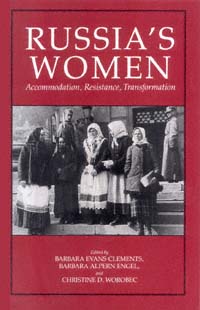 | Title: Russia's women: accommodation, resistance, transformation Author: Clements, Barbara Evans 1945- Published: University of California Press, 1991 Subjects: History | European History | Women's Studies | Russian and Eastern European Studies Publisher's Description: By ignoring gender issues, historians have failed to understand how efforts to control women - and women's reactions to these efforts - have shaped political and social institutions and thus influenced the course of Russian and Soviet history. These original essays challenge a host of traditional assumptions by integrating women into the Russian past. Using recent advances in the study of gender, the family, class, and the status of women, the authors examine various roles of Russian women and offer a broad overview of a vibrant and growing field. [brief] Similar Items |